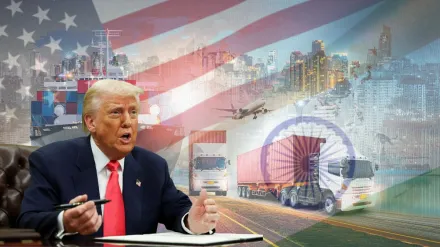In a significant development amid escalating trade tensions, the United States has imposed a 25% reciprocal tariff on certain goods exported from India, effective from August 7, 2025. This move, announced by Minister of State for Commerce and Industry Jitin Prasada in the Lok Sabha on August 12, 2025, affects approximately 55% of the total value of India’s merchandise exports to the US. However, key sectors such as pharmaceuticals and electronics have been spared additional tariffs for now, providing some relief to these vital industries.
Background of the Tariffs
The reciprocal tariffs stem from ongoing trade disputes between the two nations, where the US has sought to address perceived imbalances in trade practices. These measures are part of a broader US strategy to impose duties on imports from countries it views as having unfair trade policies. Earlier in the year, negotiations for a bilateral trade agreement between India and the US were launched in March 2025, with five rounds of talks held so far, the latest occurring from July 14-18, 2025, in Washington DC. The discussions aim to foster tariff stability and long-term trade predictability, but the imposition of these tariffs highlights persistent challenges.
The 25% reciprocal tariff targets specific goods, though exact details on the product list were not fully disclosed in the ministerial statement. This follows a US executive order in late July 2025 that modified reciprocal tariff rates to rectify trade practices contributing to imbalances. Adding to the complexity, an additional ad valorem rate of duty of 25% is set to be imposed on certain Indian exports starting August 27, 2025, potentially escalating the total duty to 50% on affected items.
Exemptions and Sectoral Impact
In a reassuring note for India’s export-driven sectors, Prasada clarified that no additional tariffs have been imposed on pharmaceuticals and electronics as yet. These industries are crucial to India’s economy, with pharmaceuticals alone accounting for a significant portion of exports to the US, valued at billions annually. Electronics, including components and devices, have also seen robust growth in bilateral trade.
The minister emphasized that around 55% of India’s merchandise exports to the US—encompassing sectors like textiles, apparel, and certain manufactured goods—are subjected to the initial 25% reciprocal tariff. The impact on these areas could vary based on factors such as product differentiation, market demand, quality standards, and existing contractual arrangements. For instance, the textiles sector, a major employer in India, may face challenges, but the government is actively monitoring developments.
Government Response and Stakeholder Engagement
Responding to queries in the Lok Sabha, Prasada assured that the Indian government is prioritizing the protection and promotion of farmers, workers, entrepreneurs, exporters, micro, small, and medium enterprises (MSMEs), and all sections of industry. “The government attaches utmost importance to protecting and promoting welfare of farmers, workers, entrepreneurs, exporters, MSMEs and all sections of industry,” he stated.
The Department of Commerce is engaging with stakeholders, including exporters and industry associations, to gather feedback on the tariffs’ impact and implement mitigation measures such as export promotion and market diversification. The ongoing bilateral trade negotiations are seen as a key avenue to resolve these issues, with India pushing for equitable terms that safeguard its interests.
Broader Implications for India-US Trade
India’s exports to the US, its largest trading partner, totaled over $80 billion in FY 2024-25, with a focus on gems and jewelry, pharmaceuticals, textiles, and engineering goods. The new tariffs could dampen growth in affected sectors, potentially leading to higher costs for US consumers and disruptions in supply chains. Analysts estimate that the 55% coverage could impact exports worth around $44 billion, based on recent trade figures.
However, the exemptions for pharma and electronics—sectors where India holds a competitive edge—offer a buffer. Pharmaceuticals, in particular, benefit from the US’s reliance on affordable generic drugs from India, which may explain the current sparing of additional duties.
This development occurs against the backdrop of global trade uncertainties, including US President Donald Trump’s aggressive tariff policies aimed at countries like India and China. Recent reports indicate further escalations, with the additional 25% duty set for late August potentially exacerbating tensions. Indian officials remain optimistic about dialogue, with Prasada noting that the Modi government “will not compromise” on national interests.
As negotiations progress, the focus will be on achieving a balanced trade deal that minimizes tariff barriers and enhances economic ties. Exporters and industry leaders are urged to adapt through diversification and innovation to weather these challenges. The coming weeks will be critical in determining the full scope of these tariffs and their long-term effects on Indo-US relations.



